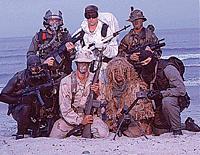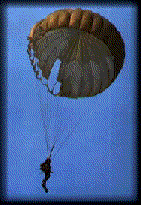

US Navy SEALs AIR)

Beads of sweat form on his brow - not so much from stress, but from the heat. The wet suit that the swimmer is wearing is designed to keep his body warm in the coldest water. But in the hot, noisy aircraft it is more than a bit uncomfortable.
But then, this swimmer has been uncomfortable before. After all, he is a Navy SEAL - nobody ever promised him air conditioning. So sitting inside an Air Force C-130 on the simmering tarmac, while definitely not the best way to spend a hot summer afternoon, is nothing he can't handle.
None too soon, the aircraft is rolling, and then airborne. The air seems to cool somewhat, but actual comfort is still out of the question.
However, comfort is not uppermost in the SEAL's mind right now; he has to concentrate on getting ready to jump out of the plane.
As far as teaching first-timers how to jump on a static line, SEAL instructors have it down to a fine art. It's an art not fully appreciated by some trainees.I really believe their philosophy is to make you so uncomfortable you can't wait to jump.
The noise and vibration inside the C-130 rattle the fillings of a jumpers' teeth as you sit crammed together. Your parachute packs force you to sit forward, on the edges of you webbed benches. As the back end of the plane gapes open for the pending jump, there is no way to control the temperature or pressure inside the aircraft; both drop quickly.
The movement of the luminescent hour hand on the diver's watch and the drone of the aircraft's four powerful engines are a jumpers' only guide to their progress toward the drop zone.
From 1,200 feet, the emergency rescue craft and back-up inflatable boats, already in the water to assist the jumpers, appear as tiny dots on the ocean's surface, far below. What does stand out is the yellow smoke that rises from a flare, giving important wind direction information.
On board the emergency rescue craft, an instructor checks the wind speed and then radios the inbound aircraft to relay the information to the SEALs.
The first thing out of the plane is the pallet, heavily loaded with the inflatable rubber raft that contains the majority of the team's gear. Next will go the jumpers.
The SEALs walk heel-to-toe, lifting their fin-clad feet high as they make their way toward the tail of the aircraft. This is an especially tricky balancing act, as the aircraft bounces around in air turbulence. Inspecting all their gear, jumpers go over a full mental check list one last time.
At the doorway the jump master gives the order, GO!
Then the SEAL is falling, floating free in the air, but not for long; in a few seconds, he is clear of the aircraft and the static line triggers the deployment of the primary chute. Then comes the powerful jerk, one the jumper feels from the tips of his toes through the top of his skull.
Recovering from the opening shock, the jumper immediately checks to ensure he has a full canopy, for canopy malfunctions must be detected and dealt with in seconds. What's true in the sea and on land is especially true in the air: quick reaction time and proper execution of techniques learned in training can mean the difference between life and death.
Now, under a full canopy, the jumper busies himself with locating the inflatable raft, called a rubber duck and finding the rest of his jump team. Using the T-10 or 7-TU parachute, the SEAL can carefully control his descent to land as close as possible to the target.
But even with these tactical considerations uppermost in your mind as you float to earth, the sensation of the incredible high!!! This experience reminds of why you chose to be a SEAL in the first place.
Ever mindful of the wind direction, you begin to loosen yourself from your parachute by disconnecting all but the most important straps as you float down to the water. A sinking parachute will drown the jumper in seconds.
This time, there won't be the swim to the inflatable raft that fell front the sky shortly before, or the boat ride to an over-the-horizon target. This time, an inflatable boat pulls up to assist the you out of the water.
There are very few people who would want to jump out of a perfectly good airplane into an ocean with three to five foot waves during daylight. Fewer still would want to try it at night.
SEALs accomplish such feats as part of standard tactical maneuvers required to arrive on target at the scene of operations.
SEALs also make air-to-land jumps or (insertions) as well as air-to-water. The aircraft used can be either helicopters or fixed-wing aircraft.
 |
There are very few people who would want to jump out of a perfectly good airplane into an ocean with three- to five-foot waves during daylight. Fewer still would want to try it at night. |
Helicopters are an ideal platform for SEAL operations because they are so versatile; they can hover close to the ground or higher up. The SEALs can perform basic insertion: jumping directly from the aircraft to the land or water, without parachutes or lines, or they can make the insertion: repelling or fast-roping.
In repelling, a pair of SEALs will balance on the skids of a helicopter, slowly lowering themselves until they are clear of the hovering craft. Once clear, it's a controlled drop to the surface, about 100 feet below.
In fast roping, you slide down a thick rope of woven wool much like firemen slide down a pole. On the signal, the SEALs, one right after the other, drop from a helicopter hovering between 50 and 75 feet above the ground. Things happen fast. An entire squad can be on the ground in three to five seconds. In fact, the whole operation is so fast that a SEAL who doesn't get clear of the rope the instant his feet hit the ground runs the risk of having a size eleven land on his head.
Whatever the insertion tactic, the objective remains the same: getting to the target quickly and safely.
And, of course, for every insertion there is an extraction. This may be as simple as waiting for a helicopter to land at a predetermined point or as complicated as coordinating the McGuire lift. In this lift, the halo crew throws out lines that the SEALs attach to (Swiss seats) ; special climbing harnesses. They are lifted clear and flown out of the area. The real trick is in the landing. The SEALs have to hit the ground running and must unhook before the helicopter drags them back into the air again.
It's all in a typical training day for the SEALs .
Once you graduate from BUDS and are hopefully assigned to a SEAL team, you realize what all that training was for. During BUDS, you are strictly survival oriented,;After BUDS, you become more oriented toward the tactical objective of the mission. A person gets a chance to go out on some of the most interesting and demanding missions in the world. The only place you can get that is in the Navy!
To some people, comfort is a warm spot under the covers or a favorite couch and the tv. To a Navy SEAL, comfort comes from a job well done and knowing that all TEAM members return:No SEAL has ever been left behind.